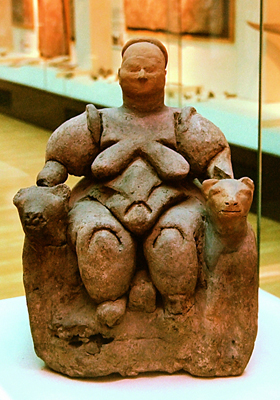| Anonymous Seated Woman Approx. 5.500 BC Museum of Anatolian Civilizations Ankara, Turkey |
|
Rights (Photo / Work):
CC-BY-SA // Wikipedia Autor: 120 List of sources: http://de.wikipedia.org/wiki/ %C3%87atalh%C3%B6y%C3%BCk |
This baked-clay sculpture was unearthed in a grain vessel at Çatal Höyük (Anatolia). The Neolithic settlement is important for research insofar as it is the first and best-preserved Neolithic site found to date. The headless figure is generally thought to depict a corpulent and fertile Mother Goddess in the process of giving birth[1] while seated on her throne which has two hand rests in the form of leopard heads. Contrary to female forms from the Upper Paleolithic, the vulva triangle and the vulva are not accentuated in a explicitely naturalistic way. The great abstraction and stylization of Neolithic goddess figures at the time is striking[2]. Birthing in order to secure the continuation of offsprings and woman's significance as life-givers still seems of central importance for the social structure of mankind at the time. (Translation: C. Wilhelm) |


